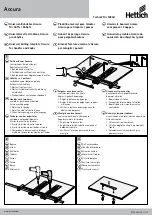
8
| English
Dust/Chip Extraction
Dust from materials such as lead-containing coatings, some
wood types, minerals and metal can be harmful to one’s
health. Touching or breathing-in the dust can cause allergic
reactions and/or lead to respiratory infections of the user or
bystanders.
Certain dust, such as oak or beech dust, is considered carci-
nogenic, especially in connection with wood-treatment ad-
ditives (chromate, wood preservative). Materials containing
asbestos may only be worked by specialists.
– Provide for good ventilation of the working place.
– It is recommended to wear a P2 filter-class respirator.
Observe the relevant regulations in your country for the ma-
terials to be worked.
u
Avoid dust accumulation at the workplace.
Dust can
easily ignite.
Operation
u
Products that are only sold in AUS and NZ:
Use a resid-
ual current device (RCD) with a nominal residual current
of 30 mA or less.
Operating modes
u
Pull the plug out of the socket before carrying out any
work on the power tool.
Adjusting the mitre/bevel angle (see figure D)
The base plate
(5)
can be swivelled to the right or left to
make mitre cuts up to 45°.
The anti-splinter guard
(12)
cannot be used while mitre cuts
are being made.
– Remove the anti-splinter guard
(12)
.
– Loosen the screw
(13)
and push the base plate
(5)
slightly towards the mains cable.
– The base plate has lock-in points at 0° and 45° on the left
and right so that precise mitre/bevel angles can be set.
Swivel the base plate
(5)
to the desired position accord-
ing to the scale
(14)
. Other mitre/bevel angles can be ad-
justed using a protractor.
– Then push the base plate
(5)
towards the saw blade
(8)
as far as it will go.
– Retighten the screw
(13)
.
Moving the base plate (see figure E)
You can move the base plate
(5)
back for sawing close to
edges.
Fully unscrew the screw
(13)
using the hex key
(4)
. Remove
the screw together with the profiled plate
(15)
.
Lift the base plate
(5)
. Move the base plate towards the
power cable so that the hole for sawing close to edges
(19)
is above the threaded hole in the power tool housing. The
positioning cam
(16)
must engage in the opening
(17)
of the
base plate at the same time. Insert the screw
(13)
along with
the profiled plate
(15)
in the threaded hole and tighten the
screw.
Sawing with an offset base plate
(5)
is only possible with a
mitre/bevel angle of 0°. In addition, the parallel guide with
circle cutter
(22)
(accessory) as well as the anti-splinter
guard
(12)
must not be used.
Starting Operation
u
Pay attention to the mains voltage. The voltage of the
power source must match the voltage specified on the
rating plate of the power tool. Power tools marked
with 230 V can also be operated with 220 V.
Switching on/off
To
switch on
the power tool, press the on/off switch
(2)
.
To
lock
the on/off switch
(2)
, press and hold it while also
pressing the locking mechanism
(3)
.
To
switch off
the power tool, release the on/off switch
(2)
.
If the on/off switch
(2)
is locked, press the switch first and
then release it.
Preselect the stroke rate
You can also preselect the stroke rate and change it during
operation using the stroke rate preselection thumbwheel
(1)
.
The required stroke rate is dependent on the material and
the work conditions and can be determined using practical
tests.
It is recommended that you reduce the stroke rate when
placing the saw blade on the workpiece and when sawing
plastic and aluminium.
The number of strokes can be adjusted using six different
settings, allowing the cutting speed, cutting capacity and the
cut itself to be optimally adapted to the material that you
want to cut.
Setting
Stroke rate,
approx.
(min
−1
)
Application/Material
0
800
Metal
1
1300
Metal, narrow curved cuts
2
1800
Narrow curved cuts
3
2200
Curved cuts
4
2600
Curved cuts
5
3000
Standard cuts, fast cuts
During prolonged periods of use at a low stroke rate, the
power tool may heat up significantly. Remove the saw blade
and let the power tool run at the maximum stroke rate for
around three minutes to cool down.
Working Advice
u
Pull the plug out of the socket before carrying out any
work on the power tool.
u
Switch the power tool off immediately if the saw blade
becomes blocked.
u
When machining small or thin workpieces, always use
a stable base or saw table (accessory).
1 609 92A 405 | (09.08.2021)
Bosch Power Tools









































